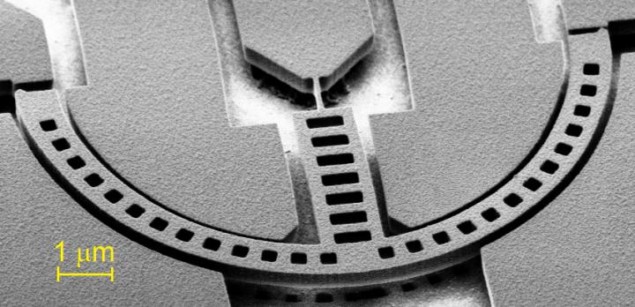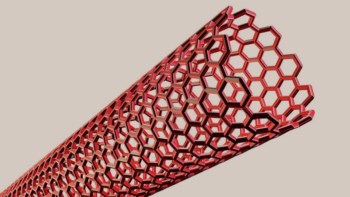
A new type of relay that retains its state even when the power is switched off could be used to make a reliable high-temperature non-volatile digital memory. The device, developed by researchers at the University of Bristol in the UK, could find use in electric vehicles, aircraft or “Internet of Things” devices that operate in harsh conditions and require electronics with integrated data storage.
Conventional transistors are ill-suited for applications in hot environments because their leakage current increases with temperature. In such conditions, nanoelectromechanical (NEM) relays are a promising alternative. They work through electrostatic actuation, in which a voltage applied between a fixed “actuation” electrode (usually called the gate) and a cantilever beam anchored at one or both ends produces an electrostatic force that attracts the beam to the gate.
As the beam moves, the air gap between the gate and beam, which can be as small as a few tens of nanometres to ensure low-voltage (and thus energy-efficient) operation, rapidly reduces. This causes the capacitance to increase. At a critical “pull-in” voltage, the electrostatic force becomes much greater than the opposing mechanical spring force. At this point, the beam snaps in, forming the relay’s “on” state.
The drawback with this mechanism is that the balance of forces immediately before the critical “pull-in” moment is very unstable, which makes it difficult to control the movement of the beam. This tends to make the device less reliable, and it can be especially problematic in non-volatile relays that use surface adhesion forces (stiction) to ensure the relay stays switched on even when the power is switched off.
Eliminating instability
A team of researchers led by Dinesh Pamunuwa has now made the first electrostatically actuated NEM relay that does not suffer from this so-called “pull-in” instability. In contrast to conventional architectures, the new device has a semi-circular beam and a novel arrangement of four gates to control the beam’s movement. One pair of gates is used to rotate the beam anticlockwise and the other pair to rotate it clockwise.
After rotation, the beam tip lands on a stationary electrode and stays connected to it thanks to surface adhesion forces, even when the power is completely switched off. When it needs to be reprogrammed, it can be rotated in the opposite direction using the opposing pair of gates.
Pamunuwa explains that the semi-circular beam and use of diagonally opposed pairs of gates for actuation ensures that the air gap to the gates remains constant throughout relay operation, eliminating pull-in instability. What is more, the architecture allows for low-voltage programming and reprogramming for memory applications, which, combined with the device’s zero off-state current leakage, greatly improves energy efficiency.

Monolayer resets record for thinnest non-volatile memory device
High-temperature tests
The Bristol researchers used their structure to make a high-temperature non-volatile NEM relay that successfully underwent 42 on-off cycles at 200°C. They also showed that the device retains its state for more than six months, boasts the highest number of reprogramming cycles to date under any environmental conditions and operates at actuation voltages as low as 1.6 V with a 120 nm actuation air gap.
The work, which is detailed in Nature Communications, is part of a long-term effort to produce digital electronic components that are highly energy efficient. Pamunuwa says that he and his colleagues are working on all aspects of NEM relay-based computing in pursuit of this goal, both at the device and system level and as EDA (electronic design automation) tools for modelling, simulation and design.
“Currently, we are working with partners in a four-year EU project called ZeroAMP, which started in January 2020, with the aim of demonstrating the first NEM relay-based field-programmable gate array (FPGA),” he tells Physics World.



